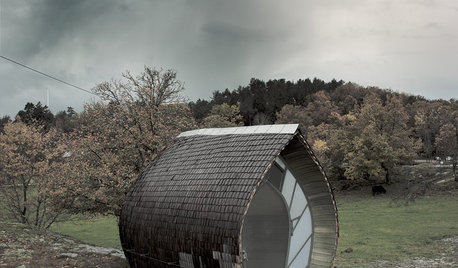Very rare sighting this morning.
ladobe
12 years ago
Related Stories

FUN HOUZZThe Unicorn in the Bathtub — and Other Mind-Blowing Sights
Fantasy and reality meet head-on in photos of costume fans in their own homes
Full Story
HOUZZ TOURSRare Modernist Home Uncovered in Palm Springs
A custom home by modernist William Krisel gets restored and updated
Full Story
KITCHEN DESIGNKitchen Details: Out-of-Sight Paper Towel Holder
See how some homeowners are clearing the counter of clutter while keeping this necessity close at hand
Full Story
KITCHEN DESIGNPlain-Sight Storage for the Kitchen Stuff You Use Most
Turn essential cookware, tools and even spices into design assets by displaying them out in the open
Full Story
HOUZZ TOURSHouzz Tour: A Rare Tiny-Home Specimen in Sweden
With a reptilian skin and unusual architecture, this small home focuses on nature and simple living
Full Story
FEEL-GOOD HOME12 Very Useful Things I've Learned From Designers
These simple ideas can make life at home more efficient and enjoyable
Full Story
LIFELate Again? Eliminate the Things Holding You Up in the Morning
If you find yourself constantly running late for appointments, work and get-togethers, these tips could help
Full Story
KITCHEN DESIGN91 Kitchen Banquettes to Start Your Morning Right
Slide into one of these stylish breakfast nooks and stay awhile
Full Story
LIFEMorning Nook Tips for Sleepyheads to Get-Up-and-Goers
Whether you whack the snooze button or spring out of bed, these ideas can help you create a refreshing space that helps you on your way
Full Story
LANDSCAPE DESIGNDiscover an Intimate Garden Nestled on a Manhattan Rooftop
As rare as a taxi on a rainy day, this New York City escape balances privacy with a gentle embrace of city sights
Full StoryMore Discussions







ericwi
MissSherry
Related Professionals
Camas Landscape Architects & Landscape Designers · La Marque Landscape Architects & Landscape Designers · Fort Payne Landscape Contractors · Kaneohe Landscape Contractors · McLean Landscape Contractors · San Antonio Landscape Contractors · Soddy Daisy Landscape Contractors · Westford Landscape Contractors · Hueytown Landscape Contractors · Candler-McAfee Fence Contractors · Bonney Lake Fence Contractors · Queen Creek Fence Contractors · The Villages Fence Contractors · Berkeley Window Contractors · The Villages Window Contractorswifey2mikey
ladobeOriginal Author
Tony G
wifey2mikey
larry_gene
ladobeOriginal Author
ladobeOriginal Author
wifey2mikey
ladobeOriginal Author
wifey2mikey
terrene
molanic
caterwallin
ladobeOriginal Author
caterwallin
bananasinohio
ladobeOriginal Author